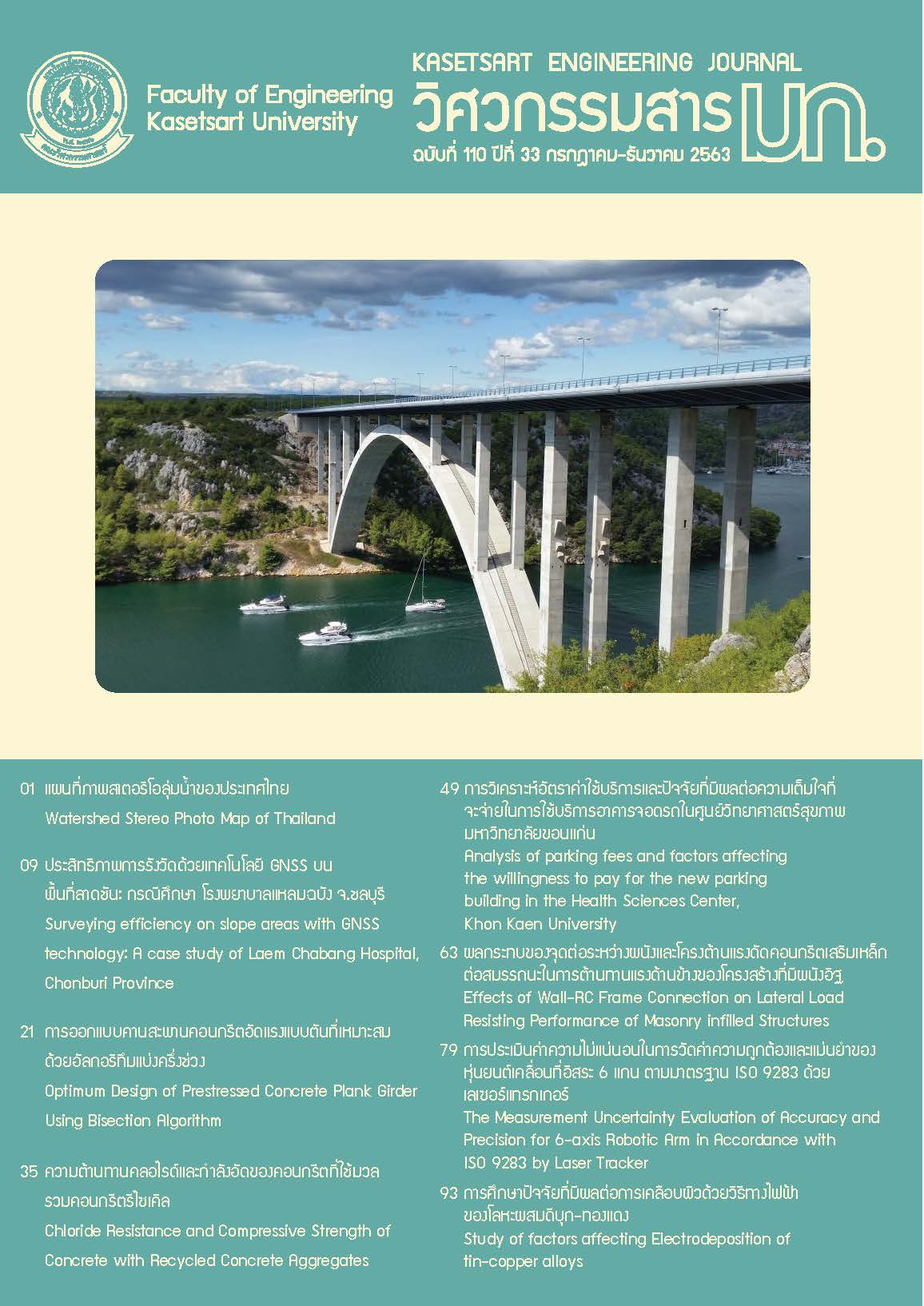Chloride Resistance and Compressive Strength of Concrete with Recycled Concrete Aggregates
Keywords:
chloride penetration resistance, compressive strength, recylced concrete aggregate, fly ash, limestone powder, concreteAbstract
This research aims to study the chloride penetration resistance and compressive strength of concrete with recycled concrete aggregate (RCA). The RCA was used to replace the coarse aggregate at the percentage replacement of 10%, 25%, 50% and 100 %. Fly ash (FA) was used as a partial binder replacement material at the percentage replacement of 20% and 30%. While, limestone powder (LP) was used to replace the binder at the percentage replacement of 10%. The water to binder ratios (w/b) were kept at the ratios of 0.40, 0.50 and 0.60. The rapid chloride penetration resistance, bulk chloride diffusion resistance and compressive strength of the concrete with RCA were conducted. Based on the experimental results, it was found that the chloride penetration resistance and compressive strength of concrete reduced with the increase of w/b and RCA amount. While, the chloride penetration resistance and compressive strength of concrete increased when the water curing was increased. Besides, the utilization of only FA could increase the chloride penetration resistance and compressive strength of concrete with RCA better than concrete with FA and LP.
References
Kou S C, and Poon C S (2012). Enhancing the durability properties of concrete prepared with coarse recycled aggregate. Construction and Building Materials, 35: 59-76.
กีรติ ชัยประเศียร และ สุรทิน สุทธิประภา (2558). ผลกระทบของมวลรวมคอนกรีตรีไซเคิลจากโรงงานคอนกรีตผสมเสร็จต่อความต้านทานคลอไรด์และกำลังอัดของคอนกรีต. ปริญญานิพนธ์, คณะวิศวกรรมศาสตร์ มหาวิทยาลัยบูรพา, ชลบุรี, ประเทศไทย
Jena T, and Panda K C (2018). Mechanical and durability properties of marine concrete using fly ash and silpozz. Advances in Concrete Construction, 6(1): 47-68.
Zunino F, Boehm–Courjault E, and Scrivener K (2020). The impact of calcite impurities in clays containing kaolinite on their reactivity in cement after calcination. Materials and Structures, 53(44): 1-15.
Mehta P K (1981). Studies on blended Portland cements containing Santorin earth. Cement and Concrete Research, 11(4): 507-518.
Mehta P K, and Monterio P J M (2006). Concrete: Microstructure. Properties and Materials. (3rd Edition), The McGraw-Hill Companies.
Massazza F (1993). Pozzolanic cements. Cement and Concrete Composites, 15(4): 185-214.
Chindaprasirt P, Jaturapitakkul C, and Sinsiri T (2007). Effect of fly ash fineness on microstructure of blended cement paste. Construction and Building Materials, 21(4): 1534-1541.
Nguyen C V, Lambert P, and Bui V N (2020). Effect of locally sourced pozzolan on corrosion resistance of steel in reinforced concrete beams. International Journal of Civil Engineering, 18: 619-630.
Arttamart S, and Sumranwanich T (2019). Compressive strength and chloride penetration resistance of concrete with fly ash, limestone powder and partial replacement of fine aggregate by bottom ash. Journal of Engineering, RMUTT, 17(2): 113-125. (in Thai)
Hussain K, Choktaweekarn P, Saengsoy W, Srichan T, and Tangtermsirikul S (2013). Effect of cement types, mineral admixtures, and bottom ash on the curing sensitivity of concrete. International Journal of Minerals, Metallurgy and Materials, 20(1): 94-105.
Deilami S, Aslani F, and Elchalakani M (2017). Durability assessment of self-compacting concrete with fly ash. Advances in Concrete Construction, 19(5): 489-499.
Sadrmomtazi A, Tahmouresi B, and Amooie M (2017). Permeability and mechanical properties of binary and ternary cementitious mixtures. Advances in Concrete Construction, 5(5): 423-436.
Sunil B M, Manjunatha L S, Lolitha R, and Subhash C Y (2015). Potential use of mine tailings and fly ash in concrete. Advances in Concrete Construction, 3(1): 55-69.
Lawrence P, Cyr M, Ringot E (2003). Mineral admixtures in mortars: effect of inert materials on short term hydration. Cement and Concrete Research, 33(12): 1939-1947.
กรมโยธาธิการและผังเมือง. มยผ. 1201-50. มาตรฐานการทดสอบหาขนาดคละของมวลรวม
American society for testing materials. ASTM 1202-97. Standard test method for electrical indication of concrete’s ability to resist chloride ion penetration. Annual Book of ASTM Standard. 2004; Vol.4.02.
American society for testing and materials. ASTM 1556. Standard test method for determining the apparent chloride diffusion coefficient of cementitious mixtures by bulk diffusion. Annual Book of ASTM Standard. 2004; Vol. 4.02.
American society for testing and materials. ASTM C1152. Standard test method for acid-soluble chloride in mortar and concrete. Annual Book of ASTM Standards. 2004; Vol. 4.02.
British Standard. BS 1881-116. Method for determination of compressive strength of concrete cubes, 1983.


